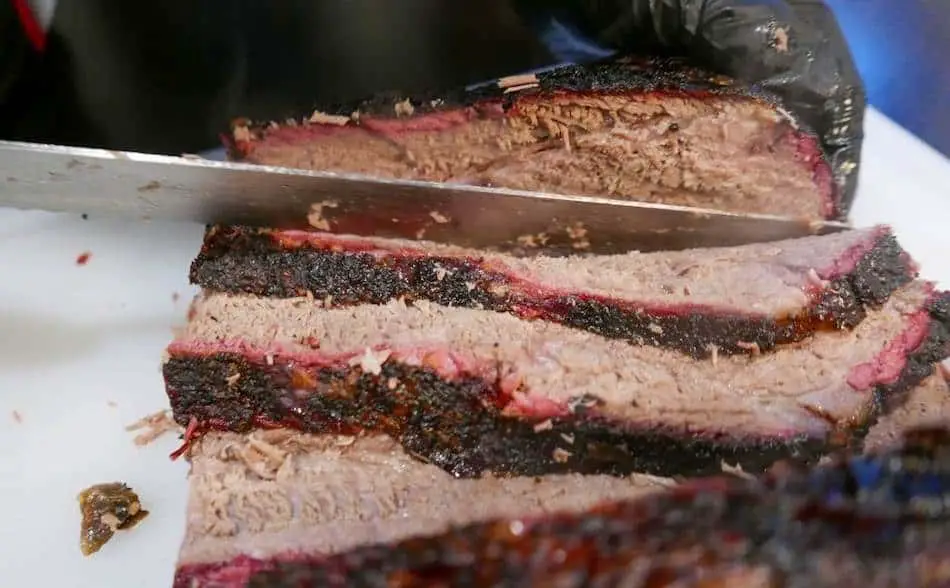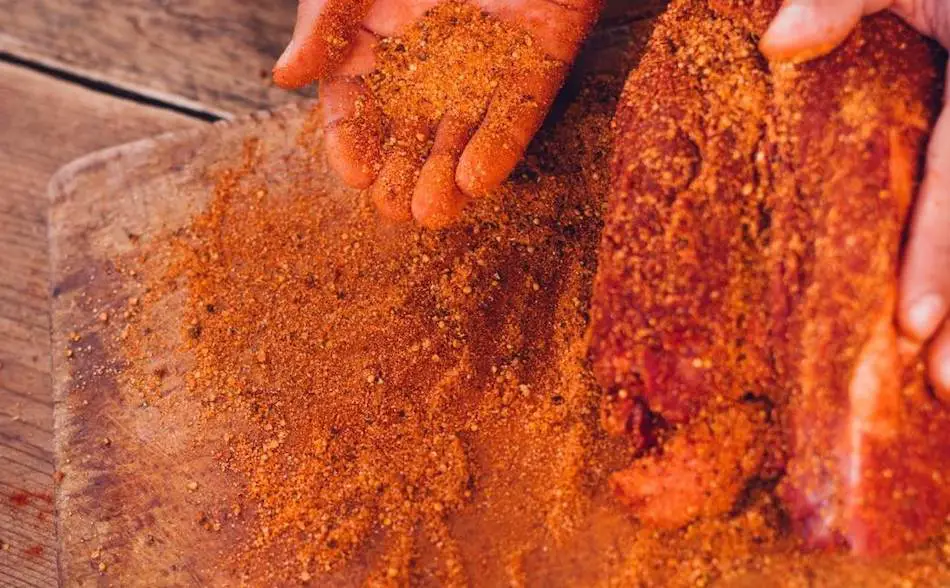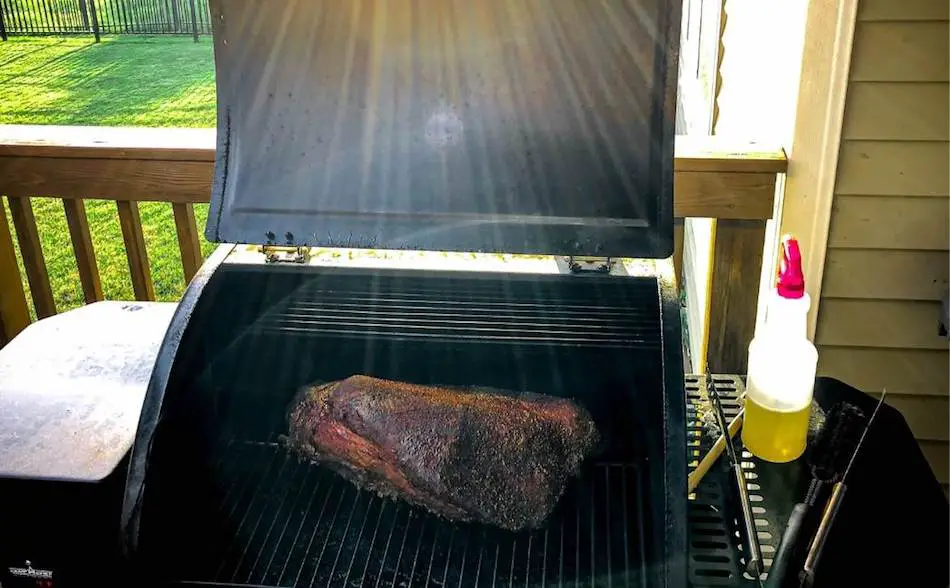
A crispy bark is one of the best features of the smoked brisket. Bark is a combination of rub, dehydrated meat and fat. The bark is formed through a series of chemical changes that take place on the outer layer of the meat called the Maillard reaction. The crusty outer layer of the brisket takes some practice to master, but if you follow a few simple tips, you can get a good bark on your smoked brisket every time. I found everything I could about brisket bark from some world’s best competition barbecue experts.
A good bark on a smoked brisket is achieved through a series of chemical reactions called the Maillard reaction, which occur on the outer layer of the meat. To get a good bark, apply a thick layer of rub to the meat before smoking it. Leave the brisket alone for the first 3-4 hours of the cook, and wait until the bark is firm before wrapping the meat. Try pink butcher paper instead of aluminum foil. For the best bark, skip wrapping altogether. The type of wood used for smoking can also affect the flavor of the bark. By following these tips, you can achieve a crispy and flavorful bark on your smoked brisket every time.
Key Points
- A crispy bark is a key feature of a smoked brisket.
- Bark is formed through the Maillard reaction, which is a series of chemical reactions that occur on the outer layer of the meat.
- To achieve a good bark on your smoked brisket, it is important to apply a thick layer of rub to the meat, leave the brisket alone for the first 3-4 hours of the cook, wait until the bark is firm before wrapping the meat, use butcher paper instead of aluminum foil to wrap the brisket, and trim excess fat from the brisket before smoking it.
- Injecting the brisket with a marinade can also help to add flavor and moisture to the meat.
- The type of wood used for smoking the brisket can also affect the flavor of the bark. Experiment with different woods to find your preference.
Tips For Achieving A Good Bark
| Tip | Description |
|---|---|
| Apply a thick layer of rub | Cover the meat in a thick layer of rub, which will help to form the bark as the meat cooks. |
| Leave the brisket alone for the first 3-4 hours | During this time, the meat will absorb smoke and form a crust. Avoid spritzing or mopping the meat during this phase. |
| Don’t wrap the brisket until the bark is firm | Wrapping the brisket too early can cause the bark to soften. Wait until the bark is crusty before wrapping the meat. |
| Use butcher paper instead of aluminum foil | Butcher paper allows the brisket to breathe and doesn’t trap as much steam, resulting in a crunchier bark. |
| Trim excess fat from the brisket | Trimming excess fat from the brisket will allow the rub to penetrate the meat more effectively, resulting in a better bark. |
| Inject the brisket with a marinade | Injecting the brisket with a marinade can add flavor and moisture to the meat, helping to improve the bark. |
| Experiment with different woods | The type of wood used for smoking the brisket can affect the flavor of the bark. Try different woods to find your preference. |
1. Apply a Thick Layer of Rub to the Brisket
The rub plays an important role in the bark’s formation, so before you smoke a brisket, cover the meat in a thick layer of rub. The meat rub ( a combination of salt, sugar, herbs, spices) plays a key role in the crust’s formation. As the meat cooks, the ingredients in the rub will dry out and dissolve in water and fat on the surface of the meat. If the meat rub contains sugar, caramelization will take place as the sugar burns. All these chemical reactions combine to create the dark mahogany skin-like layer on the brisket that we call bark.

The best brisket rubs on the market are Killer Hogs, Slap Yo Daddy, Meat Church and Butcher BBQ. You can’t go wrong with any of these pre-made rubs because they are produced by the champion pitmasters themselves. If you asked ten pitmasters to name their favorite brisket rub, you’ll probably get ten different answers. Favorite rub discussions are like asking people what their favorite wood flavor; there’s no right or wrong answer. The only way to discover your preference is to experiment.
If you don’t know where to begin, there are several brisket rubs on the market that work brilliantly with brisket.My go-to rub is made by legendary pitmaster Malcolm Reed, who produces several rubs under the brand name Killer Hogs. The TX Brisket Rub has an authentic Texan flavor and contains salt, spices, garlic, onion powder. However, the rub and a small percentage of anti-caking agents and soybean oils. For more information on brisket rubs, check out my Brisket Rub Guide where I review the best pre-made dry rubs on the market, and give you all the best homemade rub recipes used by champion pitmasters.
2. Leave the Brisket Alone For The First 3 to 4 hours
For the first 3-4 hours of the cook, leave the brisket alone. This first phase is crucial for bark development. You don’t need to spritz or mop the meat during this time, just give the meat time to absorb the smoke and form a crust. After about 3 to 4 hours, begin spritzing every hour to keep the brisket moist. If you spritz too early, the rub will run off the meat, so timing is everything.
3. Don’t Wrap the Brisket Until the Bark is Firm
Make sure you have developed a crusty bark before wrapping the brisket. Steam will cause the bark to soften once the brisket has been wrapped in foil. So if you haven’t developed a crusty bark to begin with, the crust won’t survive the wrapping phase of the cook. Some people wrap once the meat has reached an internal temperature of 150°F or 160°F, but it’s more important to go by the feel and look of the bark rather than temperature.
4. Use Butcher Paper Instead of Aluminium Foil
A brisket wrapped in butcher paper will produce a better bark than a brisket wrapped in foil. Butcher paper allows the brisket to breathe and doesn’t trap as much steam, so the bark won’t soften. The different wrappings alter the texture of the bark, and this was clear in an experiment conducted by brisket master, Aaron Franklin who smoked three briskets; one wrapped in foil, another wrapped in butcher paper, and he smoked the other brisket unwrapped. The brisket wrapped in butcher paper had a crunchier bark than the foil wrapped brisket.
The only way to find out the difference is to experiment yourself. If you have never used butcher paper, buy the right one. The butcher paper used for brisket is very specific and is free from wax and other products.
Different Butcher Papers For Smoking Meat
5. Try An Unwrapped ‘Naked’ Brisket
Wrapping brisket or the ‘Texas Crutch’ is the most popular method of smoking brisket, however, many old school Texan pitmasters don’t foil their brisket. An unwrapped smoked brisket will produce a hard, crunchy bark, but the meat will not be as moist and juicy as a wrapped brisket. An unwrapped brisket will also take longer to cook because wrapping helps the brisket push through the stall.
If you choose to smoke the brisket unwrapped, then make sure you get everything else right. Otherwise, it will end up too dry. To give your brisket the best chance, make sure you brine the meat beforehand and inject some extra liquid into the brisket prior to cooking. Also, make sure you have good control over your pit if you’re cooking on a charcoal smoker. Keep the temperature low-and-slow and spritz/mop the meat every hour to keep the meat moist.
6. Return the Brisket To The Heat Before Slicing
Some people like to finish their brisket in the oven to harden the bark just before slicing. When wrapping brisket in foil, the bark often goes mushy so to avoid this, many pitmasters return the meat to the smoker for 10-minutes for harden the bark. However, if you are using a charcoal smoker, often the fire has gone out while the brisket was in its holding/resting phase which can last for up to 4-hours. Pre-heat a conventional kitchen oven and increase the heat as high as it will go and then place the brisket inside for a short stink. Be very careful not to leave the brisket in for too long. The idea is to lose the soggy crust and help it dry a little just before slicing.
7. Spritz the Brisket to Help Set the Bark
Spritzing the brisket during the first stage of the cook is an important step in bark formation. The added moisture will help the rub fuse to the meat, forming the bark. Spraying liquid onto the brisket will also attract more smoke-which means more flavor. Be careful not to spritz too early, otherwise the rub will run off the meat and make the bark patchy. Bark formation is only one of the reasons we spritz brisket, but the main benefit of wetting meat during smoking is to slow down the cooking and keep the roast nice and moist.

8. Use A Sugary Rub to Caramelize the Bark
If you choose a sweet rub, the sugar will caramelize and add another layer of complexity to the bark. Some pitmasters believe sugar content is an important ingredient for brisket rubs, because sugar helps with the browning. However, keep in mind that if the sugar burns, it will make your meat taste bitter.
Turbinado sugar is a raw brown sugar that isn’t as refined as other sugars, and is the best sugar for rubs.Turbinado sugar can withstand heat and not burn, which makes it the best sugar for smoked brisket. Burned sugar will make your brisket taste bitter, which is why some people avoid using it as an ingredient for their rub.
9. Use a Binder to Avoid Patchy Bark
Most people apply some kind of binder to the brisket before adding the rub. A binder, or slather, helps the rub stick to the meat and avoid patchy bark. Mustard and olive oils are popular choices among many competition pitmasters. Mustard doesn’t influence the flavor of the meat, but works as a glue to bind the rub to the meat. Check out my article: Should I Slather Brisket?
How To Make Your Own Brisket Rub
A homemade brisket rub using fresh ingredients is the best way to have control over all your quantities. Also, if you don’t like products with additives, making your own is the way to go, and it’s not as complicated as it seems. Most rubs that you buy in store or online will have anti-caking agents and other additives. Making your own rub is the best way to control the salt and sugar content within the rub. Most people dry brine with kosher salt beforehand, so a rub high is salt can mess with your calculations. Find a simple homemade brisket rub recipe and then make one change at a time. To learn how to make your own brisket rub, check out my article containing Homemade Championship Brisket Recipes.
Standard Barbecue Rub

I found this great rub recipe through How To BBQ Right. I use this recipe and alter it slightly depending on what I'm cooking. Made by the guys at Townsend Spice & Supply: https://townsendspice.com/
Ingredients
- - ½ Cup Paprika
- - ½ Cup Salt
- - ½ Cup Sugar
- - ½ Cup Granulated Garlic
- - ¼ Cup Granulated Onion
- - ¼ Cup Chili
- - ¼ Cup Cumin
- - 2 Tablespoons Black Pepper
- - 2 Tablespoons Dry Mustard
- - 1 Tablespoon Cayenne Pepper
Instructions
- Combine all the spices together in a large mixing bowl
- Store rub in rub shakers
How To Make Aaron Franklin‘s Texas-Style Brisket Rub
Famous brisket master Aaron Franklin keeps it simple when applying rub to his brisket and uses a 1:1 ratio of kosher salt and 16-mesh cafe grind black pepper, and paprika for color. Aaron believes in allowing the smoke and natural meat flavors to do their work, rather than relying on the seasoning. For more information about the black pepper used in Texas rubs, you might be interested in Best Pepper For Brisket- How To Make Texas Rub.
Pre-Made Brisket Rub Comparison
The Best Salt For Brisket Rub
When choosing salt, kosher salt is the preferred salt of most pitmasters and chefs. Kosher salt has larger grains than other salts and because it contains anti-caking agents, it won’t stick together. Mortons is the most popular brand of kosher salt and it can be found in most grocery stores. Diamond Crystal is another popular choice of kosher salt and is a best seller on Amazon. Check the latest price here.
Can You Get Brisket Bark on an Electric Smoker?
If you’re smoking a brisket in an electric smoker, finish the brisket in the oven to harden the bark. The disadvantage of using an electric smoker is the temperature will only go as high as 275°F. For this reason, it’s difficult to get a crispy chicken skin or a firm brisket bark. The way around this problem is to place the brisket in the oven unwrapped for 10-minutes just before slicing.
More brisket articles:
